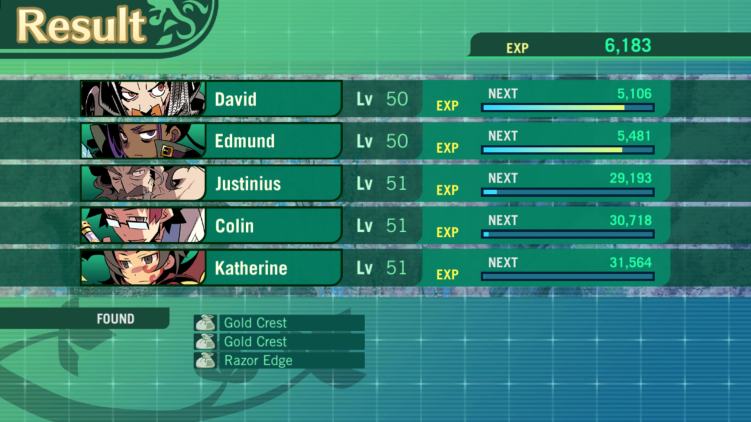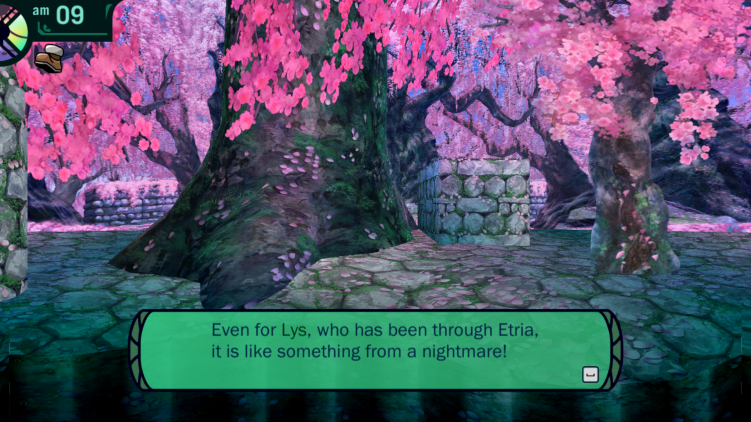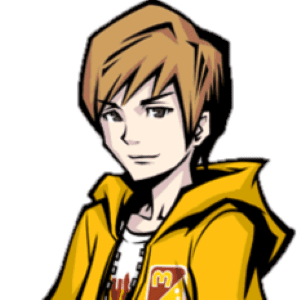Having done my dues in replaying the first game of the Etrian Odyssey Origins Collection despite having played the game before, I was most excited to move on to the other games in the set for adventures which were practically brand-new to me. Today’s title was saddled with a bit of a strange expectation for me, as many fans regard it as the weakest of the three games as well as being supposedly one of the series hardest outings, if not THE hardest one. Still, I wasn’t going to let their criticisms stop me from judging the game on its own terms, and was truly excited to see how the world of the series progressed after its maiden voyage. So grab your closest companions from the town of Etria and pick up a few new faces along the way, because we’ve got a long way to the bottom of this dungeon… well actually it’s the top this time.

Developed by Atlus and Lancarse, published by Atlus, and released in 2008, Etrian Odyssey II: Heroes of Lagaard is a cartography centric RPG for the Nintendo DS, later remastered for Nintendo Switch and PC earlier this year. Its premise involves an adventuring guild being commissioned to climb a labyrinth in a tree, braving countless monsters to reach the castle atop it. Players interact with the game through character creation and customization, dungeon traversal, turn-based combat, reading dialogue, and plenty of map drawing. Bear in mind I played the HD version on PC, so differences may pop up if you chose to play another version of the game. This review will also contain a few discussion of things that will be masked with ambiguous words but can be seen as endgame spoilers, so you have been warned.
The story in Heroes of Lagaard canonically takes place sometime after the first game, and by loading a clear save or entering a passcode from Etrian Odyssey, you can actually make it so that the game lightly acknowledges that the protagonists of both games are the same. The player arrives in the Grand Duchy of High Lagaard, where the ruling body has summoned adventurers to climb the Yggdrasil Labyrinth in the tree that their city is built around. Supposedly at the top is a legendary floating castle where the ancestors of the people of High Lagaard lived, and the journey of the game is centered around the search for that castle. I can’t say much more due to spoilers, but what I can say is that the writing in Etrian II is a noticeable step up from its predecessor. The main reason for this is that, unlike the first game where the government’s motivations to reach the end of the dungeon were rather nebulous and largely based on conjecture, the Duchy has an actual compelling reason to usher adventurers up Yggdrasil and the missions they assign feel like connected steps. It draws heavily from other stories and classical legends, but in a way that feels refreshing. The city of High Lagaard is also much better fleshed out, as the characters have much more dialogue to read if you check back with them each time you reach a new floor, and some of the side quests can tell stories over several missions and involve various residents of the city.
My only real complaint with the story really comes at the end of the adventure. Don’t get me wrong, I’m not saying it should have lived up to the quality of Etrian Odyssey I’s final stratum, because that was an amazing twist which you can only do once. However I did want to mention that once you beat the final boss, the ending narration tries to play it off as a scenario where neither side was right and it was simply a matter of strength prevailing. The more immediate problem is that it’s simply hard to read the final antagonist as anything but a villain given that there are so few things which serve to redeem their character compared to the many reasons you have to defeat them. The other issue is more a general problem that is famous in anime writing but certainly appears elsewhere, where sentiments about neither side being fully right or wrong seem to necessarily lead to stories where might makes right. In a sense Heroes of Lagaard is more honest about this in its writing, but that doesn’t change the fact that it’s a dumb trope which is contrary to objective moral truth. In summation I do believe that Etrian Odyssey II does have the better writing of the two games I have reviewed, but there are some last minute, easily avoidable fumbles which prevent it from reaching its full potential.
Gameplay once again begins at the adventurer’s guild where you are tasked with creating a party of explorers. This is also where the main reason the game is not especially newcomer friendly shows up, as you have a total of 11 classes to choose from at the start. Veteran players who already have a feel for party building should be able to navigate it well enough, especially since nine of the classes are the ones from the previous entry, but I could easily imagine a new player being overwhelmed considering that a full party of five would cover less than half of the possible options. That aside however, it’s pretty awesome that the game gives the player the opportunity to fully recreate their old guild if they’re feeling nostalgic. I personally did my customary inclusion of the healer and shielder from the first game before rounding out my party with new characters: the two classes that were progress-locked in the previous entry and one of the brand new ones. At this point fans of the series would probably be a little shocked that my setup contains only three fifths of the optimal classes, but despite the game’s balancing I found that this tackled the majority of the main story content without much issue. This is a hard game, but if you know your way around Etrian conventions already then deviating from the meta in this game is not that punishing. One final note on character classes is the unlockable Beast class being available shortly after the first boss, so unlike the first title if you really want to play with that class then the inconvenience of raising one from the ground up is significantly lower than in the previous game.

The dungeon exploration gameplay has a few changes which alter the way progress is generally pursued. The first change you’ll notice are low walls of debris which offer a look into upcoming areas before you set foot in them, allowing you to make early map notations and judge which direction you wish to explore in an interesting way. This appeared in a sort of beta form in the Azure Rainforest’s lotus puzzles from the first EO game, but this feature persists through the majority of High Lagaard’s labyrinth and it’s a welcome upgrade. Healing points have also been replaced by Geomagnetic Poles, serving as toggleable checkpoints to start you deeper into a stratum but offers no escape. Functionally going back to town to rest then starting from a Pole isn’t that different from the old system, but it does prevent certain exploits that allowed you to survive Etria’s dungeon in some rather unintended ways. The last major change being that Formido Oppugnatura Exsequens, FOEs for short, come in two extra varieties: blue ones that can move on the low wall tiles mentioned earlier, and magenta ones which don’t appear on you map and must be avoided using only your sight and radar. As a side note, the mapping system was standardized across all entries in the collection so no need to discuss it further. This does take away the experience of getting to see how the tools evolved over time, but if it makes the game more user friendly I won’t complain.
A lot of these changes are positive and do improve the game a lot, but unfortunately there is one major change that dramatically shifts the dungeon gameplay in a rather negative way. The combat in Etrian Odyssey II has been rebalanced from its predecessor to heavily favor swift conclusions, meaning that just about every monster in the game is much more lethal now. On paper this seems perfect for a sequel insofar as later entries should be more challenging, even though I felt the original game’s combat was difficult enough.The combat itself was fine, but I did wish that some of the better options in the game weren’t so luck based. I was actually able to defeat some of the game’s more infamous bosses without much trouble, but my entire success revolved around landing the fear status and hoping it lasted long enough for me to heal and dish out damage in worthwhile amounts. However for some incomprehensible reason, they reduced the amount of experience points gained from FOEs to zero. I can understand the want to protect the game from strategies which farm experience from FOEs earlier than intended and this does emphasize their role as puzzle elements of the dungeon, but this is way too punishing for a game that has already upped the ante. This slows down the pace of the game considerably, and by the time I had reached the final area of the main story I straight up stopped doing quests and just wanted to beat the final boss already. The pacing felt so off without the ability to get proper rewards for overcoming the game’s strongest hazards. I wish I didn’t have to admit that because the little bits of extra writing found in the side content is great! I truly would have been able to overlook a lot of the more annoying difficulty adjustments if this one thing wasn’t such an issue, but as it stands it really brings down the gameplay side of things.
The functions of the town facilities in Heroes of Lagaard are basically identical to the original game, so instead let us discuss the title’s presentation next. Visually speaking, the game looks similar to before but implements some smart changes, probably based on feedback from the original game. Instead of the labyrinth being pure forest, there is also the presence of ancient pillars shooting upwards in the environment around you, visually reminding you of the direction you are heading and the destination you are seeking. The dungeon wall textures are still repeated often, but the design of the textures themselves have enough extra detail that the sameness is reduced greatly. The character artwork is great too, as this is where the artist’s style began to move away from the more simple profile drawings of the adventurers and added much more action to their portraits. This has the added effect of meshing with the HD version exclusive portraits better, but they did stumble a bit in not creating variant fifth portraits for the nine returning classes, instead retaining their looks from Etrian Odyssey I. I don’t know how much money goes into each drawing, but considering this collection was a mere remaster, surely there must have been money available to commission these additional drawings. Alas, this is the one part of the game and maybe even the whole collection where we truly got skimped out on.
The music in Etrian Odyssey II is an… interesting departure for the series. The game retains the same composer and retro sound font for its soundtrack, however the mood is noticeably different. Battle themes are aggressive as heck obviously, but the field themes are much quieter, reflective, and maybe even hesitant in their tone. Instead of a rousing ensemble we’re often greeted by just a few instruments playing softly over the the adventure, almost conveying a sense that our seasoned (or otherwise) heroes are no longer motivated by the pure spirit of adventure, but a more solemn mission with great consequence for High Lagaard if we falter. It gives a better sense of beauty to the world around you, and yet paradoxically reminds you that danger lurks around every turn. Good thing we have the cheery and mellow tunes of the city to perk us up after an intense crawl, yeah? Admittedly I’m not sure if I like the direction here more than the original simply because it has fewer songs that stuck out to me immediately, but for what it’s worth I think the music is surprisingly layered and a good listen.

Finally as for what we can learn from Heroes of Lagaard from a Catholic perspective, there’s not much I can say without spoilers but I will do my best to make good allusions. Later into the game the player is presented with ideas of immortality chasing, which resulted in a lot of horrible consequences for the one chasing it and those around them. I think this can be a reminder to us that true eternity only comes after being able to accept everything our lives entail, including the death of the body. There is undeniably something deeply melancholic in witnessing the people around us and knowing deep down we all must meet that pain eventually, but Etrian Odyssey II suggests any attempt to manipulate the mysteries of life and death would ultimately lead to a madness far more disastrous than if it were left alone. God has revealed to us that there is something beyond our mortal lives to anticipate, so it is our responsibility to ready ourselves for that ultimate passage, and that includes learning to let go at some point. “It is better to go to the house of mourning than to the house of feasting, for that is the end of every mortal, and the living should take it to heart.” (Ecclesiastes 7:2) Memento mori.
In conclusion, Etrian Odyssey II: Heroes of Lagaard was a good follow-up to its predecessor and a worthy stepping stone to the series’ future. Several of its ideas ultimately wind up being very unfriendly for newcomers and just plain frustrating besides, but its strong expansion in the storytelling department, better presentation, and preservation of good ideas do make up for it in the end. It’s not as good as the first Etrian Odyssey, but it doesn’t lag behind by much. If there’s still courage left in the heroes who saved the town of Etria, then a journey to High Lagaard is worth the investment. I’m still waiting on that landed title though, Minister Dubois!
Score: 72%
Gameplay: 3/5
Story: 4/5
Art and Graphics: 3/5
Music: 4/5
Replayability: 4/5
Morality/Parental Warnings
Etrian Odyssey II: Heroes of Lagaard takes place in a fantasy setting featuring a few supernatural elements. The dungeon is populated by monsters which are generally based on animals but can also pull from mythological sources, such as one of the bosses being a harpy. Character designs of the townsfolk are basically perfect as far as modesty is concerned, but the customizable party can allow you to play as rather immodest heroes if you opt to. Character ages are usually unspecified so said designs may come across as more or less appropriate depending on your interpretation of them. The Alchemist, Hexer, and War Magus all have a magical theme to their classes. None of them are especially realistic in their depictions, although the Hexer is capable of cursing enemies, even going so far as ordering them to attack themselves with the skill “Suicide”. Battle animations are largely primitive though so on the whole the game’s violence is nothing too inappropriate to watch. Text based descriptions of scenes in the labyrinth may get a little intense in describing areas of a battle’s aftermath, but blood is essentially absent from the game visually. Foul language is refreshingly uncommon, but it can appear. One of the legends of the floating castle involves the idea that the ruler of the heavens lives there, and weirdly in one interaction this ruler is referred to as “God” with a capital G, but never again afterwards (like sometimes the ruler will be referred to as “god” or “a god” or whatever, but the capital letter just kind vanishes. Typo maybe?). The final area of the main story does include some aesthetics reminiscent of church architecture, but interestingly I found this more telling of the villain’s warped self-image as opposed to any real dig at Catholicism.
